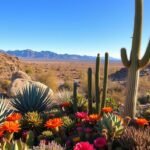Imagine stepping outside to a vibrant space buzzing with life. Many gardeners discover that choosing species naturally adapted to their region creates lasting ecological benefits. These green spaces become sanctuaries for bees, butterflies, and birds while strengthening your local ecosystem.
Why does this matter? The U.S. Fish and Wildlife Service notes that over 75% of flowering crops rely on animal helpers for reproduction. By cultivating locally evolved flora, you provide essential food sources and nesting sites. This approach requires less water and maintenance than traditional landscapes too!
In this guide, you’ll learn how to design spaces that bloom with color while serving nature’s needs. We’ll break down planning strategies, seasonal care tips, and ways to attract beneficial insects. You don’t need acres of land – even small yards or balcony containers can make a difference.
Ready to transform your outdoor area into a living network of biodiversity? Let’s explore practical steps to nurture both beauty and balance, one bloom at a time.
Native Plant Gardening: Supporting Local Pollinators and Wildlife
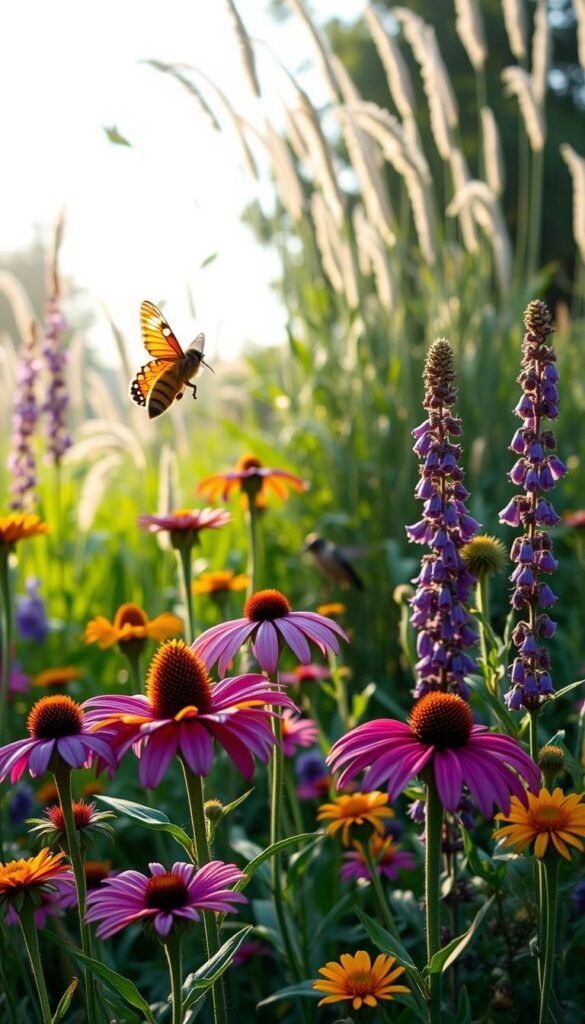
Have you ever noticed how certain flowers seem to attract swarms of bees while others stay quiet? That’s nature’s way of showing which species truly belong. Regional flora evolved alongside local fauna over thousands of years, creating relationships as precise as lock-and-key.
Nature’s Perfect Partnerships
Local pollinators like bumblebees and monarch butterflies rely on specific blooms for survival. The Pollinator Conservation Resource Center found that monarch caterpillars only eat milkweed leaves – a plant many mistake for a weed. By including these natural partners in your space, you’re rebuilding broken food chains.
Your Space as an Ecological Powerhouse
Even a modest garden patch creates critical pit stops for traveling species. The USDA PLANTS Database shows how staggered bloom times:
- Spring: Wild lupine feeds rare blue butterflies
- Summer: Coneflowers sustain goldfinches
- Fall: Asters provide last-chance nectar
When you choose regionally appropriate varieties, you’re not just planting – you’re restoring habitats. These green spaces become stepping stones between fragmented wild areas, letting creatures thrive across neighborhoods. Bonus? You’ll spend less time battling pests when nature’s balance does the work!
Benefits of Native Plants for Local Wildlife
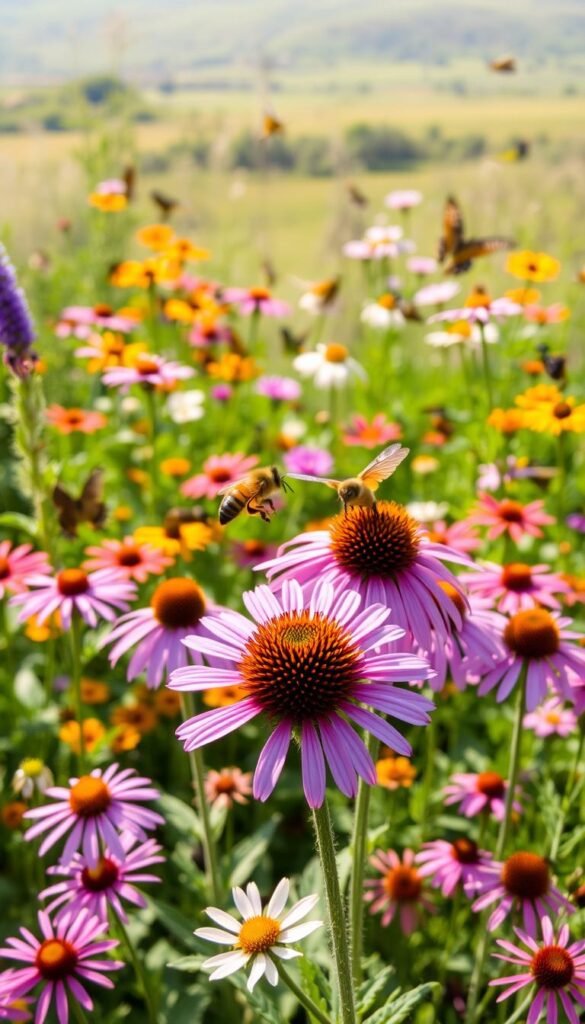
Your green space can be a lifeline for creatures big and small. When you grow species that evolved in your region, you create a ripple effect of ecological rewards. These living connections benefit both wildlife and your yard’s long-term health.
Attracting Bees, Butterflies, and Birds
Regional flora acts like a neon sign for winged visitors. Research shows monarch populations jump 60% when gardens include milkweed, their sole caterpillar food source. Sunflower seeds? They’re nature’s bird feeders. Check out this seasonal guide:
| Bloom Period | Plant Example | Attracts | Benefit |
|---|---|---|---|
| Spring | Wild Bergamot | Bumblebees | Early nectar source |
| Summer | Purple Coneflower | Butterflies | Sustains migrating species |
| Fall | New England Aster | Songbirds | Winter seed buffet |
Enhancing Soil Health and Biodiversity
Deep-rooted natives do double duty underground. Their roots break up compacted earth, letting water soak in while preventing erosion. A U.S. Fish and Wildlife study found these plants host 29x more soil microbes than non-natives!
Healthy dirt means happier plants. Beneficial fungi team up with roots to share nutrients, creating a self-fertilizing system. Over time, this living network supports everything from earthworms to ground-nesting bees.
Planning Your Pollinator Garden
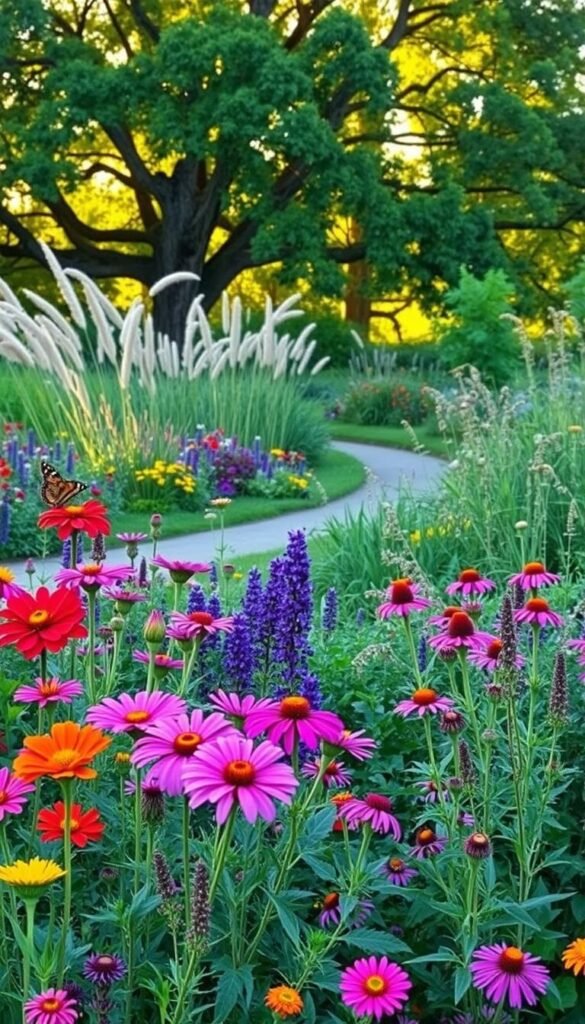
Creating a thriving habitat starts with smart design choices. Before digging in, observe your space like a detective. Watch how sunlight moves across your area and note spots sheltered from harsh winds. These details determine which plants will flourish.
Sunlight Savvy and Wind Protection
Most flowering plants need 6+ hours of direct sun daily. Use free apps like Sun Seeker to track light patterns. Got a windy balcony? Cluster pots near walls or use tall grasses as natural windbreaks. Conservationists at Lady Bird Johnson Center recommend leaving some leaf litter – it shelters overwintering pollinators.
Soil Secrets Uncovered
Grab a handful of dirt. Does it clump or crumble? Sandy soils drain fast, while clay holds moisture. Try this quick test:
- Dig a 6-inch hole
- Fill with water
- Time how long it drains
Drains in 1 hour? Perfect for drought-tolerant species. Takes 6+ hours? Choose moisture-loving asters or cardinal flowers. Local extension offices often provide free soil testing kits – a game-changer for matching plants to your conditions.
Your climate plays starring role too. Coastal gardens might need salt-tolerant species, while mountain plots require cold-hardy varieties. By aligning choices with nature’s blueprint, you’ll create a garden that buzzes with life year after year.
Selecting the Right Native Plants for Your Garden

Choosing the perfect greenery for your space begins with understanding nature’s calendar. Timing blooms to match seasonal patterns ensures continuous food sources while creating visual interest. Let’s explore how to make choices that satisfy both aesthetics and ecology.
Researching Local Species and Their Bloom Times
Start with your zip code. Tools like the Lady Bird Johnson Wildflower Center database reveal which flowers thrive in your area. Look for staggered bloom periods to maintain nectar availability from spring through fall. For example:
| Region | Early Bloomer | Mid-Season | Late Bloomer |
|---|---|---|---|
| Northeast | Wild Columbine | Bee Balm | Goldenrod |
| Southwest | Desert Marigold | Penstemon | Apache Plume |
Connect with regional societies – many offer free planting guides tailored to local ecosystems. Their expertise helps you avoid invasive look-alikes that harm pollinators.
Seeds vs. Nursery Plants: Which Is Right for You?
Seeds cost less but demand patience. Prairie dropspeed grass might take 2 years to flower from seed. Nursery-grown plants give instant impact, though prices add up. Consider these factors:
- Budget: Seeds = $3/packet vs. Potted plants = $12 each
- Timeline: Annual blooms vs. 3-year establishment period
- Skill Level: Seed stratification needs vs. Plug-and-play roots
Many nurseries now label true native plants – check for scientific names like Asclepias tuberosa instead of vague terms like “wildflower mix.” Pair early-blooming asters with late-season goldenrod to create a pollinator garden that works overtime.
Planting Techniques for a Vibrant Garden
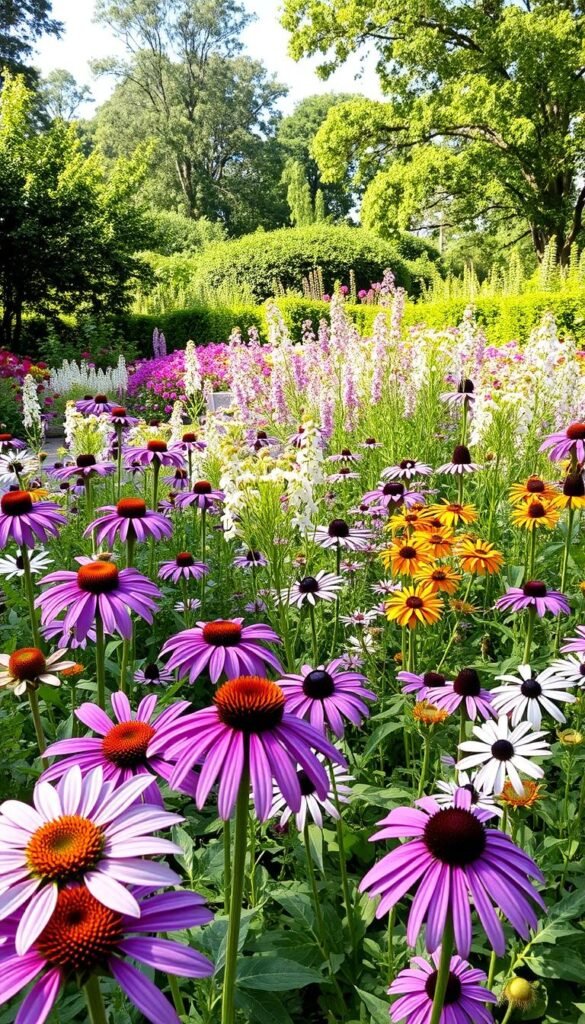
What’s the secret to turning dirt into a thriving ecosystem? It starts with smart groundwork. Proper preparation creates ideal conditions for roots to spread and plants to flourish, which in turn draws pollinators like hummingbirds and bees.
Prepping Beds, Containers, and Composting Tips
Begin by testing your soil pH – most regional species thrive in slightly acidic conditions (5.5-6.5). For garden beds, remove invasive weeds and loosen compacted earth with a broadfork. Container growers should mix 2 parts potting soil with 1 part coarse sand for drainage.
| Method | Key Steps | Benefits |
|---|---|---|
| Raised Beds | Layer compost + native topsoil | Warms faster in spring |
| Containers | Add perlite for aeration | Mobility for sun tracking |
| Composting | 3:1 brown-to-green ratio | Nutrient-rich humus |
Boost fertility naturally by layering fallen leaves and grass clippings. The U.S. Fish and Wildlife Service recommends letting compost cure for 6 months before use.
Effective Planting and Mulching Strategies
Time transplants for cool mornings to reduce shock. Dig holes twice as wide as root balls, then backfill with original soil. For seeds, follow depth guidelines – too deep and they’ll struggle to sprout.
Apply 2-3 inches of shredded bark mulch, keeping it 3 inches from stems. This locks in moisture while discouraging weeds. Studies show mulched beds require 35% less watering – a win for you and thirsty pollinators!
Remember: healthy roots mean vigorous growth. With these techniques, your space becomes a magnet for biodiversity while cutting maintenance time.
Caring for Your Native Pollinator Garden
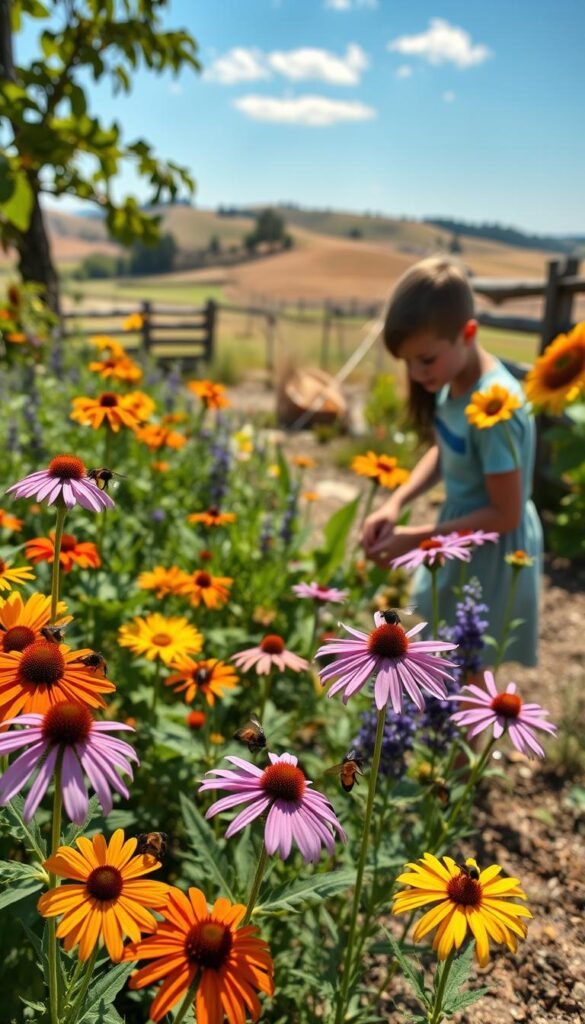
A thriving habitat needs thoughtful care to sustain its buzzing visitors. Simple, consistent practices keep blooms healthy while protecting delicate ecosystems. Let’s explore how to nurture your space without disrupting nature’s rhythm.
Watering, Weeding, and Seasonal Maintenance
Deep, infrequent watering encourages strong roots. Aim for 1 inch weekly – use a rain gauge to track natural rainfall. Morning irrigation reduces evaporation and prevents fungal issues.
Pull weeds when soil is moist to remove entire roots. Leave some “messy” areas – fallen leaves shelter butterfly chrysalises. Follow this seasonal checklist:
- Spring: Trim dead stems 6 inches above ground
- Summer: Deadhead spent flowers to prolong blooms
- Fall: Leave seed heads for winter bird food
Reducing or Eliminating Pesticide Use
Chemical treatments often harm beneficial insects. The Xerces Society reports that 90% of moth species decline in areas using synthetic pesticides. Try these alternatives instead:
- Handpick pests during early morning inspections
- Spray neem oil mixtures for aphid control
- Encourage ladybugs with dill or fennel plantings
For persistent issues, consider eco-friendly pest control solutions that target specific invaders without collateral damage. Healthy soils naturally resist infestations – your patience will reward you with balanced, self-regulating habitats.
Valuable Resources for Native Pollinators and Wildlife

Knowledge transforms good intentions into impactful actions. Finding trusted resources helps you create habitats that truly benefit your area’s ecosystem. Let’s explore tools to boost your success.
Online Databases and Conservation Centers
Start with the USDA PLANTS Database – it reveals which species thrive in your zip code. The Pollinator Conservation Resource Center offers free planting blueprints, while the Lady Bird Johnson Wildflower Center provides bloom-time calculators. These tools help match native plants to your soil and climate.
Local Native Plant Societies and Expert Guides
Regional groups like the Missouri Prairie Foundation share area-specific wisdom. Many offer:
- Seed swaps for rare varieties
- Workshops on rain garden design
- Certification programs for habitats
Connect with master gardeners through extension offices. Their on-the-ground experience helps avoid invasive species pitfalls. Together, these resources turn your garden into a conservation powerhouse that supports winged visitors year-round.
Embracing Your Journey to a Flourishing Pollinator Haven
Your efforts to cultivate life-sustaining spaces create ripples far beyond your backyard. By selecting species that match your climate and nurturing healthy soil, you’re building a living network. Each flowering stem offers nectar for bees and pollen for butterflies, forming the foundation of a resilient habitat.
Remember: strategic choices amplify impact. Staggering bloom times ensures year-round food, while avoiding pesticides protects delicate ecosystems. Studies show gardens with 5+ flower types host 4x more birds and insects. Even small steps—like adding a water dish with stones—become lifelines.
Your space does double duty as a conservation hub and inspiration for neighbors. As Dr. Mei Lin notes, wild-style plots teach flexibility—every “imperfection” strengthens biodiversity. Why not blend wild aesthetics with intentional choices? Movable containers let you adapt while complying with local rules.
Keep learning and sharing. Your thriving gardens prove that beauty and ecology coexist. Every seed sown writes a brighter chapter for pollinators—and for future generations who’ll inherit Earth’s delicate balance.



